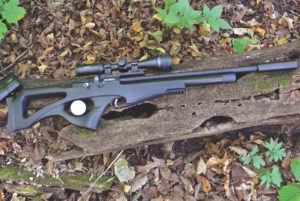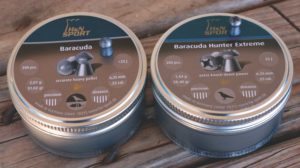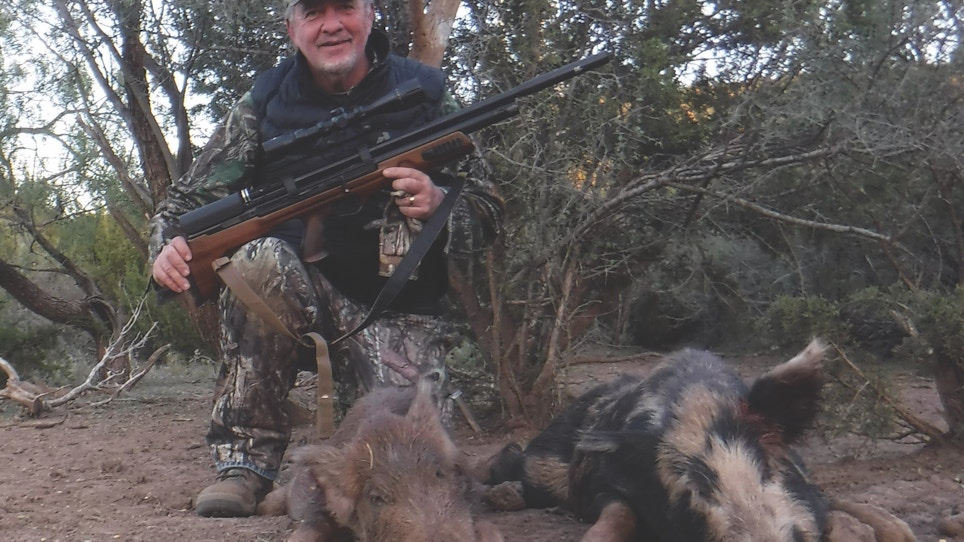Two small pigs down, both headshots in side of 60 yards with the Hatsan BullBoss .25 caliber bullpup. (Photo: Jim Chapman)
Over the last few years, the capabilities of the modern airgun has become more widely understood and accepted. Several states have included provisions in their regulations for hunting with big-bore airguns. At the same time, a few hunters started to show videos of feral hogs being taken with spring-piston airguns, which, while possible, is considered very ineffective and moreover, unethical by most experienced airgun hunters. Some of these videos showed pigs being head shot at close range with a .177 rifle generating less than 18 ft./lbs. For context, this is less than less than 1/5 the energy of a .22LR round, with a pellet weight that is a fraction of the rimfire, in a platform that is inherently more difficult to shoot accurately.
I have shot truckloads of small game and varmint with .177 air rifles, and there is no way that I will ever be convinced this gun is, or could be, an effective tool for use on anything larger than a raccoon under the right conditions. It is true that you can kill almost anything with almost anything — sometimes. But you must be close, your shot must be perfect and you must be consistently lucky. Most hunters that have spent much time in the field know this is a difficult trifecta to hit!
I receive a fair bit of mail, often from young hunters new to the sport. They bought a .177 or .22 spring-piston air rifle and want to know if this is a good gun for shooting hogs. They want to know where to shoot. I tell them this is not the right rifle for the job. Some come back angrily with “well I saw (so and so) on a video killing a hog with this gun, so why can’t I? I try to explain that these shots are staged, the situation controlled and a clean kill might be achieved once in 100 shots. Unfortunately, the video needed to mislead the novice hunter into thinking that a lightweight springer is a good choice for a pig gun, only needs that one shot.

The Brocock Compatto is probably my favorite small game rifle, and I stacked up the little piggies with it! (Photo: Jim Chapman)
Trial and error
I have taken hogs and coyotes with smaller caliber guns in the early days of airgun hunting, because we were trying to figure out the capabilities of these guns. As I thought through the situation and realized people were going to try to hunt hogs with standard-caliber airguns, I decided to take a stab at setting some boundaries based on realistic field conditions. My working hypothesis was that with a lighter-weight standard-caliber projectile, it would be necessary to control the range and use precise shot placement to the animal’s brain.
In choosing the rifle(s) to hunt with, I set a few ground rules: I would use .22-, .25- or .30-caliber pre-charged pnuematic rifles (PCP), I would use guns generating over 40 ft./lbs. and0 I would keep the range inside of 50 yards. My reason for choosing to shoot only PCPs and not spring-piston guns is twofold. First, no commercially available spring-piston rifle could generate the power I believe an ethical shot calls for. Secondly, it is difficult for most shooters to achieve the type of accuracy required to drop a pellet down the ear of a hog at 30 yards under field conditions, let alone a more typical 50-yard range.
So about three years ago I started carrying along a small-caliber gun on the occasional hog hunt to see how they would work. In addition, on a few occasions when I was out hunting rabbits, an opportunity came up to take a pig with my small-game gun. During this period, I have shot 18 feral hogs with airguns in .22 to .25 calibers, and have come to my own conclusions that will guide my hog hunting efforts in the future.
I decided to take only headshots, because having shot over 150 hogs with big-bore air rifles (.357-50 caliber), I know for a fact even a .50 caliber at 300 ft./lbs. will not drop a body shot pig every time. I take it on blind faith that a 30-grain .25-caliber pellet at 40 ft./lbs. is not going to do anywhere near as well as a 300-grain .457-caliber pellet at 300 ft./lbs. on body shot, therefore the choice to use headshots seems an obvious one to me.

My preference is for a solid roundnose like the Baracuda (l), though the Hunter Extreme looks interesting as well. I’ll try this out next. (Photo: Jim Chapman)
Maximum Range
The next thing to settle on is a maximum range. With some rifles I might be more confident stretching out a bit further, but in any event the boundary I set for myself was to keep the range inside of 60 yards. With all my hunting rifles, I can keep the pellet inside 1 inch at these distances. As a rule, I shoot off sticks or rested, though when I get an in-close shot will take a knee or go prone. I’ll take offhand shots at 60 yards all day long with a centerfire but not an airgun, as the margin of error just does not allow for effective near misses on vital organs.
I initially shot a few larger pigs with less-than-stellar results. Of the 18 pigs in this cohort, 15 were less than 100 pounds and three were larger (around 150 pounds). Of the smaller pigs, I had clean kills on 14 and one took an additional shot. Of the larger pigs, one was a less than optimal kill, and two ran off and were not heard from again. Based on this I’ve added another rule: Pass on the big pigs! You could argue that three big pigs represent a statistically small data set, but I feel if I have my 40 ft./lbs. Hatsan BullBoss .25 or my 30 ft./lbs. Brocock Compatto and a sub-100-pound pig steps out at 60 yards, I feel confident that I can jump on my sticks and cleanly drop that animal. Conversely, the same example but the hog is larger —say 130 pounds — my confidence goes down the hopper and that’s not the time to pull the trigger.
A good question is why hunt hogs with a standard-caliber rifle rather than a big bore. I’ll start off by saying that in most situations, for the vast majority of hunters, the big bore is a better option. The only situations where the smaller caliber makes sense is if an opportunistic shot presents, you’re out hunting small game with your 40 ft./lbs. .25 rifle and a pig steps into view. If he’s small and the situation lines up with the boundaries I’ve laid out — pop him! Or if you need to do pest control in an area where you want to limit the possibility of collateral damage and want to be stealthy, a small bore may be a better fit than a big-bore rifle.
Two of the rifles I’ve used for pig hunts are the Brocock Compatto .22 and the Hatsan BullBoss .25 models. The BullBoss is a bullpup design with a nine-shot magazine that is generating about 45 ft./lbs. and is a tack driver. My Compatto is a .22-caliber 30 ft./lbs. semi-bullpup using a 10-shot magazine. It is one of the most accurate field guns I’ve used and one of my personal favorite small-game guns. Both rifles are compact, ergonomic, quiet and easy to shoot from just about any convoluted position I find myself in.
The ammunition I use, a heavy, round-nose Diabolo pellet, has common traits regardless of caliber. The best balance between shooting characteristics and terminal performance. You want the pellet to hold together and penetrate as far into the brain as possible. My Compatto prefers the JSB Exact Jumbo 18.13-grain pellets, and the BullBoss digest the H&N Baracuda 31.02-grain pellets the best.
If you want to hunt pigs seriously, a powerful big bore is the best tool for the job. If you need to shoot pigs in sensitive areas where carrying distances, power and noise levels are a consideration, a small bore may be a better option for you. If you are out small-game hunting with a more powerful small bore and opportunity to take a pig becomes available, you can often take that shot. But remember, headshots only! Keep the range inside of 60 and keep in mind its small bores for small boars and let the big ones walk!
More top picks from Predator Xtreme:
How to scout in summer for coyotes
3 tips to hunt coyotes the simplest way possible
Coyote 101: Understanding how songdogs rear pups
Wild hogs: A must-hunt species






